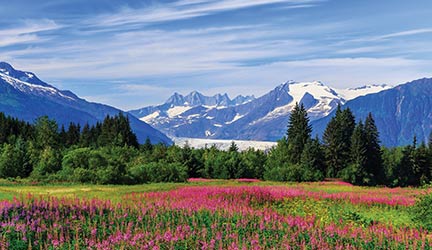Our guests come to Alaska for two major reasons: to see beautiful scenery and to see iconic wildlife. As a former Wildlife Biologist for the U.S. Forest Service in the Pacific Northwest, I love sharing my enthusiasm for wildlife with our guests.
Our crew all love Alaska and are always on the lookout for wildlife and will share wildlife sightings. I have had more than one lecture or meal interrupted by an announcement of a bear or whale sighting so all can enjoy. It’s why I often bring my camera to lectures and meals.
The best months for wildlife sightings during an Alaskan cruise typically span from May to September. During this period, the weather is milder, and many animals are active, making it easier to spot them in their natural environment. Each month brings its own unique opportunities for wildlife encounters, with certain species being more prevalent during specific times of the year.
Here's a glimpse of the incredible wildlife you may encounter during an Alaskan cruise:
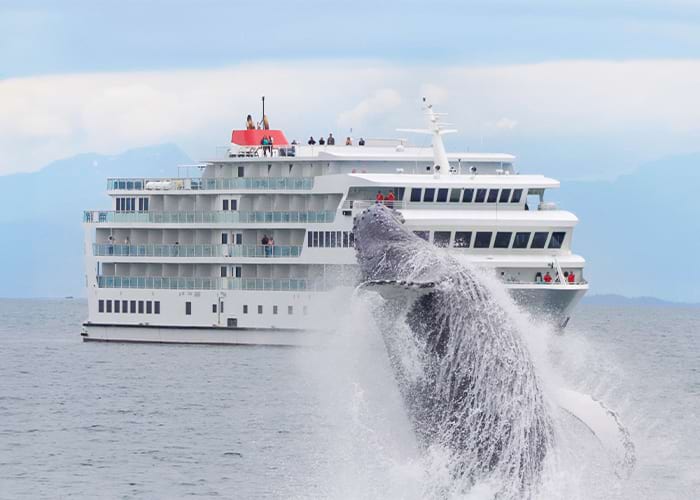
Whales
Whales are high on everyone’s wish list. Humpback whales are the most common whales we encounter on our journey, particularly from June to August. A common place to see humpback whales is soon after we leave Juneau. They come here to feed. I always tell our passengers to look for a flock of seagulls feeding in a small area. This indicates a “bait ball” – a big bunch of small fish – the primary food for humpback whales. They use a practice called bubble nets to gather the fish in a ball. They then come up in unison, mouths open to gulp in the fish. While that is spectacular, one of my favorite encounters with humpback whales happened in the middle of the night. Late one August night, our captain had awakened us to announce the presence of northern lights. After almost everyone had returned to bed, I lingered out on deck. In the dark and near silence I could hear the sounds of humpback whales exhaling – it was magical. The other most popular whale to see are “killer whales” which can be spotted June to September. Their better name is Orca, and they are not whales at all but are actually the largest member of the dolphin family. They can be encountered anywhere in Alaskan waters. Traveling in pods, their beautiful black and white markings and acrobatic behaviors make them exciting to watch. Other whales found in Alaskan waters are the gray whale, fin whale, Sei whale, blue whale, and minke whale. These whales are more solitary so harder to find.
Smaller cetaceans to be on the lookout for are Dall’s porpoises, harbor porpoises and Pacific white-sided dolphins. Dall’s porpoises swim so fast, they leave a “rooster tail” behind. With their black and white marking, they are often mistaken for baby orcas. Harbor porpoises are so busy feeding, they rarely spend much time on the surface so once seen are quickly gone. Pacific white-sided dolphins usually travel in very large groups and like to bow ride beside the ship.
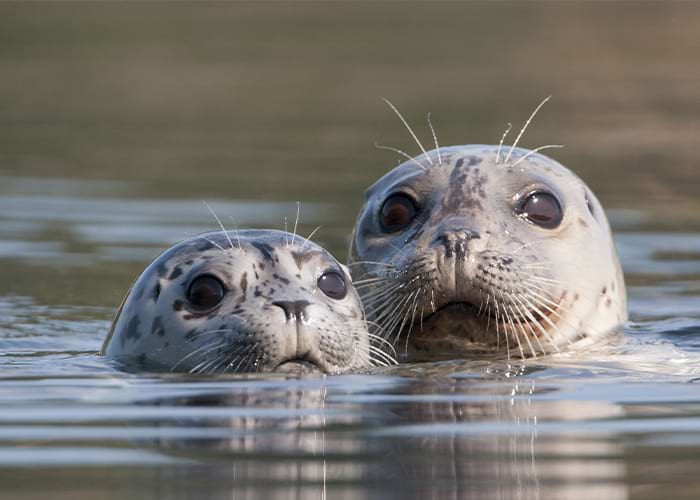
Harbor Seals
Cetaceans are not the only marine mammals to enjoy. The very cute harbor seals, which can be spotted year-round in Alaska, are often seen resting on chunks of ice, and are commonly seen in Glacier Bay, near the LeConte Glacier and Tracy Arm. Young pups can swim almost immediately after birth and are weaned after just one month. Their larger cousins - the Steller sea lions - are always seen in Glacier Bay and sometimes at other places along the coastline. The huge males can be over 1,200 lbs., more than twice as big as the females. Steller sea lions are named for Georg Steller; a naturalist who traveled with Vitus Bering in the 1740.
But everyone's favorite sea mammal is the sea otter which are most active during the cruising season from May to September. They were driven to near extinction by hunters making a fortune by selling the otters' luxurious pelts. Since the 1911 International Fur Seal Treaty, the 1972 Marine Mammal Protection Act and the 1973 Endangered Species Act, otter populations are making a comeback. We often see them as we enter Glacier Bay. They are usually floating on their backs, often with a baby on their belly as we sail by.
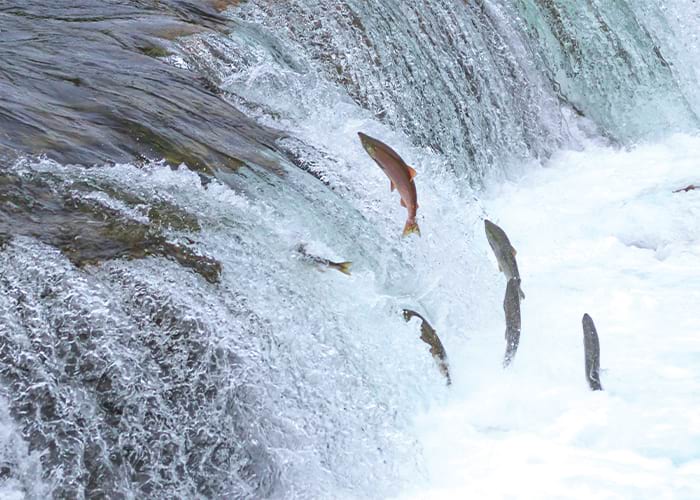
Salmon
Salmon are an iconic and vital component of Alaska's ecosystems. Salmon migration typically occurs during specific seasons, with different species migrating at different times. Guests may observe salmon migrating through the nutrient-rich waters along the coast. They may also be seen while observing other wildlife, such as bears and eagles who feed on their abundance during a salmon run.

Black & Brown Bears
Everybody wants to see bears. Summer is prime bear-viewing season in Alaska, especially in areas where salmon runs occur. While sometimes seen from the ship along the coastline, guests have a better chance of seeing them on our shore excursions. Guests often see bears on the complimentary Valley of the Eagles Nature & Wildlife Expedition in Haines. But to be almost guaranteed to see bears, you need to go on The Wild Bears of Anan excursion in Wrangell. There, both black and brown bears gather to feed on spawning pink salmon. It takes a little bit of effort to hike to the observation platform, but the reward will be enthralling.
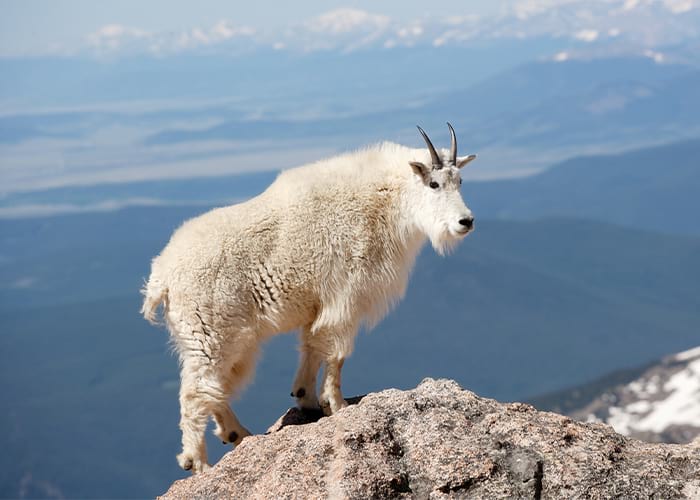
Mountain Goats
Another mammal often seen in Glacier Bay during our cruising season is the mountain goat. Our captain will make a slow pass by Gloomy Knob where mountain goats can be seen anywhere from the water line to the top of the cliffs. They can travel over what appears to be impossible cliffsides. You would think their white coats would make them easy to spot, but the Knob is often covered with snow patches. So, we are looking for snow patches that are moving. Early in the summer, the mountain goats look very shaggy as they are shedding their thick, winter coats. Native Americans would gather this shed wool to use in their woven blankets, capes, etc.
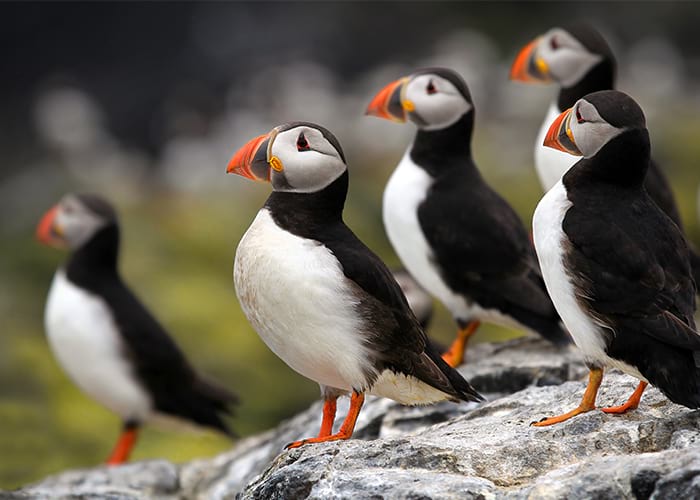
Eagles, Puffins, & Other Birds
Are you a bird nerd like me? Then Alaska will not disappoint. Bald eagles are so common, sometimes we start to equate them to pigeons. With the white heads and tails of the adults, they are easy to spot. I usually tell our passengers to look for “golf balls sitting in a tree.” Since fish are their primary food, we can see them anywhere along the coast. We often encounter one of my favorite birds at several of our docks and harbors. I tell our guests if they hear what sounds like a dog playing with a squeaky toy to look around for a black duck-like bird with bright red feet, red mouths, and white-wing patches. These are the pigeon guillemots.
Guillemots are members of the Alcid group of birds, so their close cousins are murres, auklets, murrelets, and puffins. The best place that we see these seabirds is during the day we sail into Glacier Bay. Common murres look like penguins but can fly. Everyone loves it when we see the colorful tufted puffins. And keep a keen eye and you might also see the cute horned puffins. A common trait of alcids is they must run along the water to be able to take off and landings are comical as they basically crash land on the water. Rhinoceros auklets, marbled murrelets, surf scoters, black-legged kittiwakes, mergansers, gulls, and terns can also be added to our bird checklist on our Alaska cruise.
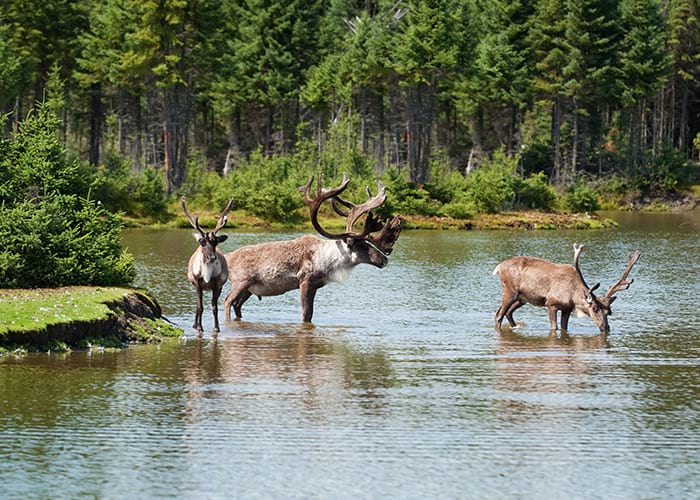
Caribou, Wolves, & More
To see many, many more kinds of wildlife, you will want to add the Alaska National Parks land tour to your cruise.
Denali National Park is home to a variety of land mammals and birds. You might see moose, caribou, Dall sheep, grizzly bears, black bears, wolves, marmots, pikas, red foxes, snowshoe hares, willow ptarmigans, golden eagles, and Canada jays on your Guided Tundra Wilderness Exploration. Moose are the largest member of the deer family. Males can reach over 1,600 lbs. and each year grow a new set of antlers that can weigh up to 80 lbs. They are usually found in dense stands of willow, aspen, and birch shrubs. Both male and female caribou will grow antlers. When caribou are domesticated, they are called reindeer. Dall sheep are beautiful white bighorn sheep. Denali National Parks is recognized as one of the best places in the world for people to see wolves in the wild. Snowshoe hares and willow ptarmigans are brown in the summer but in the winter turn pure white so they can always blend in with their environment. Your naturalist guides will tell you so many more facts about all the animals you see.
On your Kenai Fjords Wildlife and Glacier Cruise, you will have an excellent opportunity to see the abundant sea mammals and bird life found in Kenai Fjords National Park. The waters here are famous for the abundance of humpback whales, orcas, and other sea mammals. Many seabirds nest on the rocky cliffs in the fjords so be on the lookout for horned and tufted puffins, common and thick-billed murres, black oyster catchers (they look like a black duck smoking a carrot), gulls, bald eagles, and so many more.
While in Anchorage, you will have two opportunities to learn more about Alaska’s wildlife at the Alaska Sealife Center and the Alaska Wildlife Conservation Center. These research and rescue centers allow close encounters with wildlife that are not possible in the wild.
Come See Alaskan Wildlife on a Cruise with American Cruise Lines
So come to Alaska to enjoy the abundance of wildlife against a beautiful background of mountains, glaciers, and the sea. Choose from our 9-day Southeast Alaska cruise, 12-day Alaska Explorer cruise, 16-day Alaska Inside Passage cruise, 16-day Alaska National Parks, or 19-day Grand Alaska National Parks. Your heart and mind will be fulfilled from the wonder of it all.


